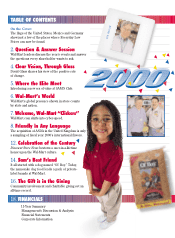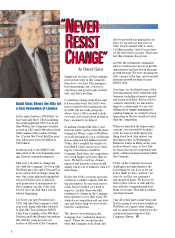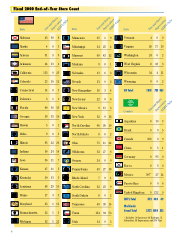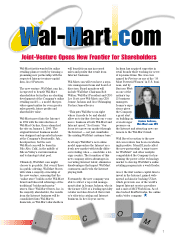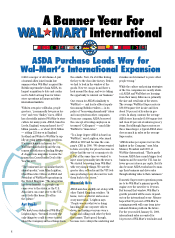Walmart 2000 Annual Report Download - page 12
Download and view the complete annual report
Please find page 12 of the 2000 Walmart annual report below. You can navigate through the pages in the report by either clicking on the pages listed below, or by using the keyword search tool below to find specific information within the annual report.
U.S. and U.K. store managers quickly
turned into exchange students when
ASDA became part of the Wal-Mart
family last summer, joining a trans-
Atlantic buddy program that’s given
both sides new retailing ideas and
enduring friendships.
“It’s a very interesting experience,
really,” says Andy Davies, manager of
an ASDA store in Burnley, England,
and one of the first to make the
exchange in October, 1999.
“Regardless of the location, it seems,
our people make the difference.”
The feeling is shared by Collin
Claunch, Andy’s “buddy” and manager
of the Wal-Mart Supercenter in
Denton, Texas.“The ASDA colleagues
are just like us,” Collin says. “They’re
not in the banana business, they’re not
in the George clothing business.
They’re in the people business. That’s
why the acquisition has gone so well.”
By the end of this year, every ASDA
store manager will visit a Wal-Mart
Supercenter in the states, and the
respective U.S. store managers will
make the trip to the United Kingdom
to study an ASDA store.
The interest of the media was intense
on both sides of Andy and Collin’s
exchange. Collin did interviews with a
local school in England and the BBC.
And when Andy came to the states, he
actually filmed a documentary for
the BBC.
Andy has made the most of the
buddy program by involving all his
store “colleagues,” who are excited
about the association with Wal-Mart.
“At my store, I’ve got two plaques up
with pictures of the two of us visiting
Collin’s store,” Andy says.“Then
we’ve got a notice board where any-
thing that Collin sends me through
e-mail or fax is posted, such as
weekly store sales and the items that
sold well. It’s almost like having a
pen pal. We share a lot of information
and we speak once a week.”
“Twice a day now in our store, we
actually do a ‘rap’ Collin taught us
that’s very much like the Wal-Mart
Cheer,” Andy says.
Likewise, Collin says the buddy pro-
gram has energized his Denton
store. “My folks think Andy is just
neat,” he says. “They might have had
some apprehension about ASDA, but
they know Andy, so if Andy says
that’s how it is, that’s fine. ASDA has
such phenomenal sales per square
foot that my people are amazed. ”
Outside the stores, Andy and Collin
made sure to share important cul-
tural experiences. Collin took Andy
to a Dallas Cowboys football game,
for example, and Andy reciprocated
with tickets to a big soccer match
between England and Scotland.
Andy came away from the states fas-
cinated with some of the products
carried at the Supercenters, espe-
cially hot dogs in a can. Inspired, he
plans to bring canned Frankfurters to
his ASDA store and promote them as
his personal VPI (volume-
producing item).
Collin, on the other hand, was awed
by ASDA’s efficient milk-stocking
system, in which milk racks roll
directly off the truck and into a
recessed refrigerator in the wall,
removing the need to hand-stock the
jugs on refrigerated shelves. It’s an
idea he’d love to steal.
⋆
Andy Davies (L) and Collin Claunch
alarmed to find greeters talking to them when
they entered the stores, the friendly, smiley-
faced Wal-Mart culture has now established a
firm foothold.
Lessons Learned
But cultural transitions haven’t always been
this smooth for Wal-Mart International.
In Argentina, for example,
Wal-Mart initially faced chal-
lenges in adapting its U.S.-based
retail mix and store layouts to the local cul-
ture. From the meat counter to the hardware
and jewelry departments, Wal-Mart had to
learn quickly and work hard to adjust the
stores’ offerings to Argentine tastes.
Compounding the challenges, Wal-Mart didn’t
anticipate the heavier Argentine customer
traffic, which temporarily overwhelmed the
stores’ relatively narrow aisles. Today,
Wal-Mart has adjusted to all these cultural
nuances, and offers Argentine shoppers the
products they desire in a comfortable environ-
ment with wider aisles. Specialized cuts of
meat have been added to the stores, and the
jewelry line has been retooled to emphasize
simple gold and silver, in keeping with the
local fashion.
“It wasn’t such a good idea to stick so closely
to the domestic Wal-Mart blueprint in
Argentina, or in some of the other interna-
tional markets we’ve entered, for that matter,”
says John Menzer. “In Mexico City we sold
tennis balls that wouldn’t bounce right in the
high altitude. We built large parking lots at
some of our Mexican stores, only to realize
that many of our customers there rode the
bus to the store, then trudged across those
large parking lots with bags full of merchan-
dise. We responded by creating bus shuttles
to drop customers off at the door. These were
all mistakes that were easy to address, but
we’re now working smarter internationally to
avoid cultural and regional problems on the
front end.”
Lifting Off in Latin-America
Overall, Wal-Mart’s future in Latin America
looks bright. In this decade, Wal-Mart plans
to capture a greater share of the Argentine
retail market, estimated at $69 billion by lead-
ing analysts. Currently, Wal-Mart has 10
Supercenter stores in Argentina.
Buddies Cross Atlantic For Fresh Ideas
(continued from previous page)


